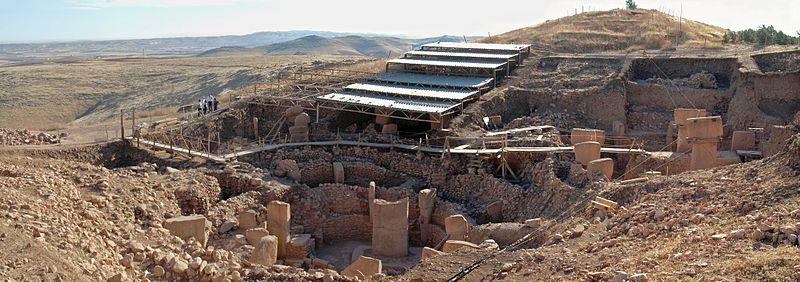

GOBEKLI TEPE EXCAVATION
Dee Finney's blog
start date July 20, 2011
today's date May 26, 2013
page 508
TOPIC: GOBEKLI TEPE: AND ANCIENT SITE BEING EXCAVATED IN TURKEY
NOTE: I DON'T PERSONALLY UNDERSTAND WHY WRITERS ARE CALLING THIS A 'CULT OF THE DEAD' LIKE IT WAS SOMETHING
NEGATIVE. THEY EVIDENTLY REVERED THEIR DEAD AS MUCH AS WE DO OURS. JUST BECAUSE THEY WERE HERE BEFORE
CHRISTIANITY DOESN'T MAKE THEM A 'CULT'.
Some of the pillars were destroyed by farmers trying to get rid of rocks that were in their way to farm their crops.
Göbekli Tepe| Göbekli Tepe | |
|---|---|
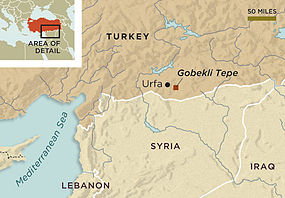 |
|
| Location | near Şanlıurfa |
| Region | Southeastern Anatolia Region, Turkey |
| Coordinates | 37°13′22″N 38°55′15″E / 37.222777°N 38.920833°ECoordinates: 37°13′22″N 38°55′15″E / 37.222777°N 38.920833°E |
| Type | Temple |
| History | |
| Periods | pre-pottery Neolithic A–B |
| Site notes | |
| Condition | well preserved |
| Website | references:[1] Megalithic Portal |
Göbekli Tepe Turkish: [ɡøbe̞kli te̞pɛ][2] ("Potbelly Hill"[3]) is an early Neolithic sanctuary located at the top of a mountain ridge in the Southeastern Anatolia Region of Turkey, northeast of the town of Şanlıurfa (formerly Urfa / Edessa). It was built of massive carved stones about 11,000 years old, crafted and arranged by prehistoric people who had not yet developed metal tools or even pottery.[4]
It was first noted in a survey conducted by Istanbul University and the University of Chicago in 1964. It recognized that the rise could not entirely be a natural feature, but postulated that a Byzantine cemetery lay beneath. The survey noted a large number of flints and the presence of limestone slabs thought to be grave markers. The hill had long been under agricultural cultivation; generations of local inhabitants had frequently moved rocks and placed them in clearance piles, possibly destroying much archaeological evidence in the process.
German archaeologist Klaus Schmidt, now of the Deutsches Archäologisches Institut, was working as part of a team at a nearby site but at the same time looking for another site to dig leading a team of his own. He reviewed the archaeological literature on the surrounding area, found the Chicago researchers’ brief description of Göbekli Tepe, and decided to give it another look. “Within minutes”, he said, he realized that the flint chips on the surface of the tell were prehistoric.[5] The following year (1995) he began excavating there in collaboration with the Şanlıurfa Museum. T-shaped pillars were soon discovered. Some had apparently undergone attempts at smashing, probably by farmers who mistook them for ordinary large rocks.[6]
Schmidt's view, shared by most experts, is that Göbekli Tepe is a stone-age mountain sanctuary. Radiocarbon dating as well as comparative, stylistic analysis indicate that it is the oldest religious site found to date.[6][7][8] Schmidt believes that what he calls this "cathedral on a hill" was a pilgrimage destination attracting worshipers up to 100 miles (160 km) distant. Butchered bones found in large numbers from local game such as deer, gazelle, pigs, and geese have been identified as refuse from food hunted and cooked or otherwise prepared for congregants.[9]
The tell has a height of 15 m (49 ft) and is about 300 m (984 ft) in diameter. And some 760 m (2,493 ft) above sea level
The imposing stratigraphy of Göbekli Tepe attests to many centuries of activity, beginning at least as early as the epipaleolithic, or Pre-Pottery Neolithic A (PPNA), in the 10th millennium BC. The PPNA buildings have been dated to about the close of the 10th millennium BCE. There are remains of smaller houses from the Pre-Pottery Neolithic B (PPNB) era and a few epipalaeolithic finds as well.
There are a number of radiocarbon dates (presented with one standard deviation errors and calibrations to BCE):
| Lab-Number | Date BP | Cal BCE | Context |
|---|---|---|---|
| Ua-19561 | 8430 ± 80 | 7560–7370 | enclosure C |
| Ua-19562 | 8960 ± 85 | 8280–7970 | enclosure B |
| Hd-20025 | 9452 ± 73 | 9110–8620 | Layer III |
| Hd-20036 | 9559 ± 53 | 9130–8800 | Layer III |
The Hd samples are from charcoal in the lowest levels of the site and would date the active phase of occupation. The Ua samples come from pedogenic carbonate coatings on pillars and only indicate a time after the site was abandoned—the terminus ante quem.[10]
At this early stage of the site's history circular compounds or temenoi first appear. They range from 10 to 30 meters in diameter. Their most notable feature is the presence of T-shaped limestone pillars evenly set within thick interior walls composed of unworked stone. Four such round structures have been unearthed so far; geophysical surveys indicate that there are 16 more, enclosing up to eight pillars each, amounting to nearly 200 pillars in all. The slabs were transported from bedrock pits located approximately 100 meters (330 ft) from the hilltop, with workers using flint points to cut through the bedrock.[11]
Two taller pillars are at the centre of each circle. The circles were probably roofed, and the pair of central pillars may have helped support the roof but this is conjectural. Stone benches designed for sitting line the interior.[12] Many of the pillars are decorated with abstract, enigmatic pictograms and carved animal reliefs. The pictograms may represent commonly understood sacred symbols, as known from Neolithic cave paintings elsewhere. The reliefs depict lions, bulls, boars, foxes, gazelles, donkeys, snakes and other reptiles, insects, arachnids, and birds, particularly vultures. (At the time the shrine was constructed, the surrounding country was much lusher and capable of sustaining this variety of wildlife, before millennia of settlement and cultivation led to the near–Dust Bowl conditions prevalent today.)[6] Vultures also feature prominently in the iconography of Çatalhöyük and Jericho; it is believed that in the early Neolithic culture of Anatolia and the Near East the deceased were deliberately exposed in order to be excarnated by vultures and other carrion birds. (The head of the deceased was sometimes removed and preserved—possibly a sign of ancestor worship.)[13] This, then, would represent an early form of sky burial, as still practiced by Tibetan Buddhists and by Zoroastrians in Iran and India.[14]
Few humanoid figures have surfaced at Göbekli Tepe. However, some of the T-shaped pillars have human arms carved on their lower half, suggesting that they are intended to represent the bodies of stylized humans (or perhaps gods). Loincloths also appear on the lower half of a few pillars. The horizontal stone member on top is thought to symbolize a human head. The pillars as a whole therefore have an anthropomorphic identity.[15] Whether they were intended to serve as surrogate worshipers, symbolize venerated ancestors, or represent supernatural, anthropomorphic beings is not clear.
The discovery of a predator—a crocodile, perhaps, built low to the ground, very muscular, shown with teeth bared and distinguished by a long tail that nearly doubles back on itself—has excited particular interest for being carved almost in the round, hinting at a degree of artistic training and social diversification again surprising in a hunter-gatherer society. (Pillar 27, Enclosure 2, Layer III).
Some of the floors in this, the oldest layer, are made of terrazzo (burnt lime), others are bedrock from which pedestals to hold the large pair of central pillars were carved in high relief.[16] Radiocarbon dating places the construction of these early sacred circles in the range of 9600 to 8800 BC; carbon dating suggests that (for reasons unknown) the enclosures were also backfilled during the Stone Age.
Creation of the circular enclosures in layer III later gave way to the construction of small rectangular rooms in layer II. Rectangular buildings make a more efficient use of space compared with circular structures. They are often associated with the emergence of the Neolithic.[17] But the T-shaped pillars, the main feature of the older enclosures, are also present here, indicating that the buildings of Layer II continued to serve as sanctuaries.[18] Layer II is assigned to Pre-Pottery Neolithic B (PPNB). The several adjoining rectangular, door- and windowless rooms have floors of polished lime reminiscent of Roman terrazzo floors. Carbon dating has yielded dates between 8800 and 8000 BC.[19] Several T-pillars up to 1.5 meters occupy the center of the rooms. A pair decorated with fierce-looking lions is responsible for the name "lion pillar building" by which their enclosure is known.[20] Here too is found a Venus accueillante figure roughly incised on the surface of a bench between two interior pillars. Comparing it with the careful execution of the bas-reliefs found on the pillars, Schmidt characterizes it as "graffiti".[21]
Layer I is the uppermost part of the hill. It is the shallowest, but accounts for the longest stretch of time. It consists of loose sediments caused by erosion and the virtually uninterrupted use of the hill for agricultural purposes since it ceased to operate as a cult center.
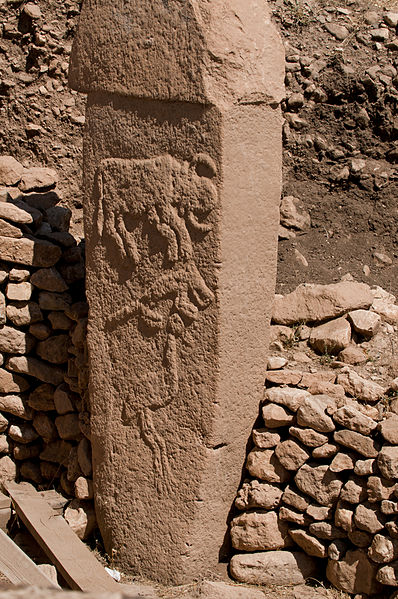
The site was deliberately backfilled sometime after 8000 BCE: the buildings were buried under debris, mostly flint gravel, stone tools, and animal bones that must have been imported from elsewhere.[22] In addition to Byblos points and numerous Nemrik points, Helwan-points and Aswad-points dominate the backfill's lithic inventory.
All statements about the site must be considered preliminary, as less than 5% of the site has so far been excavated, and Schmidt plans to leave much of it untouched to be explored by future generations (when archaeological techniques will presumably have improved).[6] While the site formally belongs to the earliest Neolithic (PPNA), up to now no traces of domesticated plants or animals have been found. The inhabitants are assumed to have been hunters and gatherers who nevertheless lived in villages for at least part of the year.[23] So far, very little evidence for residential use has been found. Through the radiocarbon method, the end of Layer III can be fixed at c. 9000 BCE (see above) but it is believed that the elevated location may have functioned as a spiritual center c. 11,000 BCE or even earlier.
The surviving structures, then, not only predate pottery, metallurgy, and the invention of writing or the wheel; they were built before the so-called Neolithic Revolution, i.e., the beginning of agriculture and animal husbandry around 9000 BCE. But the construction of Göbekli Tepe implies organization of an advanced order not hitherto associated with Paleolithic, PPNA, or PPNB societies. Archaeologists estimate that up to 500 persons were required to extract the heavy pillars from local quarries and move them 100–500 meters (330–1,640 ft) to the site.[24] The pillars weigh 10–20 metric tons (10–20 long tons; 11–22 short tons), with one still in the quarry weighing 50 tons.[25] It is generally believed that an elite class of religious leaders supervised the work and later controlled whatever ceremonies took place here. If so, this would be the oldest known evidence for a priestly caste—much earlier than such social distinctions developed elsewhere in the Near East.[6]
Around the beginning of the 8th millennium BCE "Potbelly Hill" lost its importance. The advent of agriculture and animal husbandry brought new realities to human life in the area, and the "Stone-age zoo" (Schmidt's phrase applied particularly to Layer III, Enclosure D) apparently lost whatever significance it had had for the region's older, foraging, communities. But the complex was not simply abandoned and forgotten to be gradually destroyed by the elements. Instead, each enclosure was deliberately buried under as much as 300 to 500 cubic meters (390 to 650 cu yd) of refuse consisting mainly of small limestone fragments, stone vessels, and stone tools; many animal, even human, bones have also been identified in the fill.[26] Why the enclosures were buried is unknown, but it preserved them for posterity.
Schmidt considers Göbekli Tepe a central location for a cult of the dead. He suggests that the carved animals are there to protect the dead. Though no tombs or graves have been found so far, Schmidt believes that they remain to be discovered in niches located behind the sacred circles' walls.[6] Schmidt also interprets it in connection with the initial stages of an incipient Neolithic. It is one of several sites in the vicinity of Karaca Dağ, an area which geneticists suspect may have been the original source of at least some of our cultivated grains (see Einkorn). Recent DNA analysis of modern domesticated wheat compared with wild wheat has shown that its DNA is closest in sequence to wild wheat found on Mount Karaca Dağ 20 miles (32 km) away from the site, suggesting that this is where modern wheat was first domesticated.[27] Such scholars suggest that the Neolithic revolution, i.e., the beginnings of grain cultivation, took place here. Schmidt and others believe that mobile groups in the area were compelled to cooperate with each other to protect early concentrations of wild cereals from wild animals (herds of gazelles and wild donkeys). Wild cereals may have been used for sustenance more intensively than before and were perhaps deliberately cultivated. This would have led to early social organization of various groups in the area of Göbekli Tepe. Thus, according to Schmidt, the Neolithic did not begin on a small scale in the form of individual instances of garden cultivation, but developed rapidly in the form of "a large-scale social organization"[28]
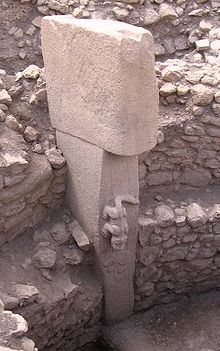
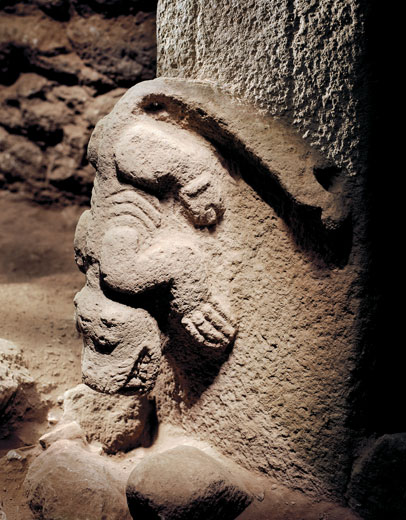
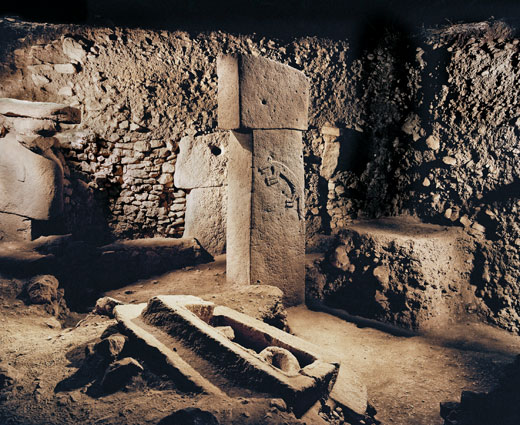
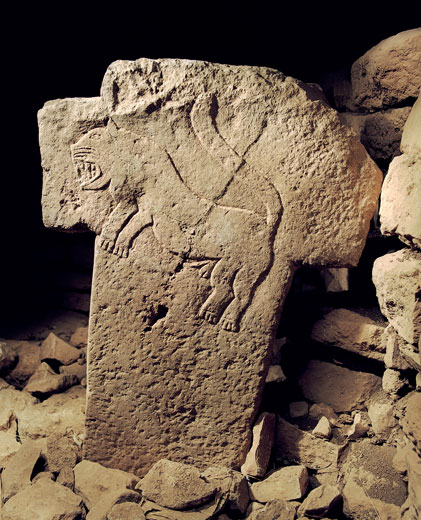
Schmidt has engaged in some speculation regarding the belief systems of the groups that created Göbekli Tepe, based on comparisons with other shrines and settlements. He assumes shamanic practices and suggests that the T-shaped pillars may represent mythical creatures, perhaps ancestors, whereas he sees a fully articulated belief in gods only developing later in Mesopotamia, associated with extensive temples and palaces. This corresponds well with an ancient Sumerian belief that agriculture, animal husbandry, and weaving were brought to mankind from the sacred mountain Du-Ku, which was inhabited by Annuna deities, very ancient gods without individual names. Schmidt identifies this story as a primeval oriental myth that preserves a partial memory of the emerging Neolithic.[29] It is also apparent that the animal and other images give no indication of organized violence, i.e. there are no depictions of hunting raids or wounded animals, and the pillar carvings ignore game on which the society mainly subsisted, like deer, in favor of formidable creatures like lions, snakes, spiders, and scorpions.[6][30][31]
Göbekli Tepe is regarded as an archaeological discovery of the greatest importance since it could profoundly change our understanding of a crucial stage in the development of human society. "Göbekli Tepe changes everything" (Ian Hodder of Stanford University). In the view of David Lewis-Williams (Professor of Archaeology at Witwatersrand University in Johannesburg), "Göbekli Tepe is the most important archaeological site in the world." It seems that the erection of monumental complexes was within the capacities of hunter-gatherers and not only of sedentary farming communities as had been previously assumed. In other words, as excavator Klaus Schmidt puts it, "First came the temple, then the city."[32]
Not only its large dimensions, but the side-by-side existence of multiple pillar shrines makes the location unique. There are no comparable monumental complexes from its time. Nevalı Çori, a Neolithic settlement also excavated by the German Archaeological Institute and submerged by the Atatürk Dam since 1992, is 500 years later, its T-shaped pillars are considerably smaller, and its shrine was located inside a village; the roughly contemporary architecture at Jericho is devoid of artistic merit or large-scale sculpture; and Çatalhöyük, perhaps the most famous Anatolian Neolithic village, is 2,000 years younger.
At present, though, Göbekli Tepe raises more questions for archaeology and prehistory than it answers. We do not know how a force large enough to construct, augment, and maintain such a substantial complex was mobilized and compensated or fed in the conditions of pre-sedentary society. We cannot "read" the pictograms, and do not know for certain what meaning the animal reliefs had for visitors to the site; the variety of fauna depicted, from lions and boars to birds and insects, makes any single explanation problematic. As there seems to be little or no evidence of habitation, and the animals pictured are mainly predators, the stones may have been intended to stave off evils through some form of magic representation; alternatively, they could have served as totems.[33] The assumption that the site was strictly cultic in purpose and not inhabited has also been challenged by the suggestion that the structures served as large communal houses, "similar in some ways to the large plank houses of the Northwest Coast of North America with their impressive house posts and totem poles."[34] It is not known why every few decades the existing pillars were buried to be replaced by new stones as part of a smaller, concentric ring inside the older one.[35] Human burial may or may not have occurred at the site. The reason the complex was carefully backfilled remains unexplained. Until more evidence is gathered, it is difficult to deduce anything certain about the originating culture or the site's significance.
Future plans include construction of a museum, and converting the environs into an archaeological park, in the hope that this will help preserve the site in the state in which it was discovered.[36]
In 2010, Global Heritage Fund (GHF) announced it will undertake a multi-year conservation program to preserve Göbekli Tepe; partners include Klaus Schmidt and the Deutsches Archäologisches Institut, German Research Foundation, Şanlıurfa Municipal Government, and the Turkish Ministry of Tourism and Culture.[37]
The stated goals of the GHF Göbekli Tepe project are to support the preparation of a Site Management and Conservation Plan, construction of a shelter over the exposed archaeological features, training community members in guiding and conservation, and helping Turkish authorities secure UNESCO World Heritage Site designation for GT.[1]
|
|
Wikimedia Commons has media related to: Göbekli Tepe |
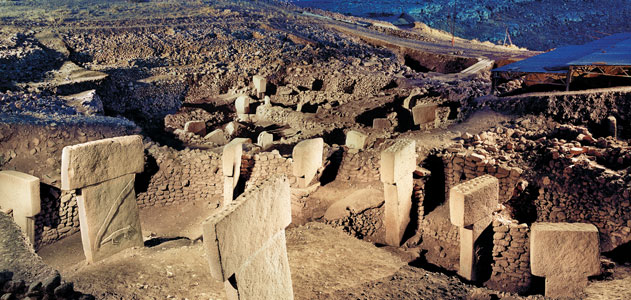
|
|
||
|
|
||
|
|||
BLOG INDEX 2011
BLOG INDEX 2012 - page 1
JANUARY THRU APRIL 2012
MAY THRU AUGUST 2012
SEPTEMBER THRU DECEMBER
BLOG INDEX 2013
BLOG INDEX - PAGE 2 - 2013